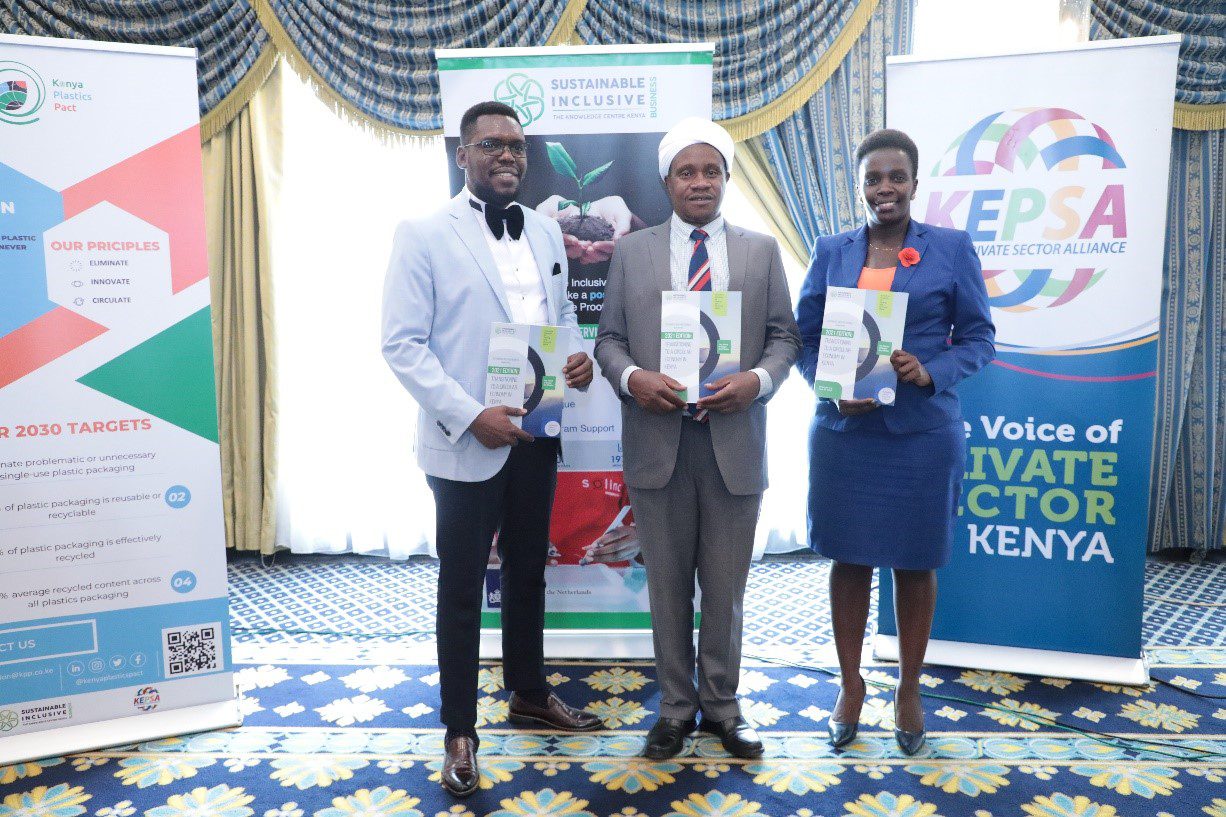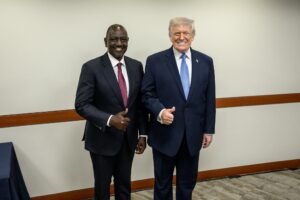By
Cynthia Kenyani
According to the
Sustainable Inclusive Business (SIB-K) in their Sustainability Magazine 2021, a
shift to a circular economy will keep materials in use, and protect and restore
the environment.
Sustainable
Inclusive Business (SIB-K), the Knowledge Center under the Kenya Private
Sector Alliance (KEPSA) Foundation, has published the first edition of the
Sustainable Inclusive Business Magazin.
(L-R) Ebenezer Amadi, SIB-K Program Manager, Dr. Ayub
Macharia, Director of Environmental Education and Awareness, MoEF; Martha
Cheruto, KEPSA Deputy CEO Foundation.
Dubbed,
“Transitioning to a Circular Economy in Kenya” this 2021 edition highlights
Kenya’s efforts in transitioning from the linear economy model. It further uses
private-sector case studies to showcase innovative solutions for dealing with
electronic waste, the threat of single-use plastics, the road toward achieving
a blue economy in Kenya, and businesses as a force for good in the wake of the
Covid-19 pandemic.
Business
innovation and growth decisions need B2B partnerships and multi-stakeholder
relationships to increase capacity, efficiency, and ease of implementation.
In
this regard, SIB-K has been a major enabler of Public-Private Partnerships
within KEPSA, providing critical opportunities to draw linkages among various
stakeholders in the public and private sectors to speed up the transition to a sustainable
economy.
“Our
Sustainability Pillar has guided us in championing the adoption of green and
blue economy principles. SIB-K contributes to the transition to a circular
economy, Kenya’s vision 2030, and the Sustainable Development Goals.
Through initiatives such as Creating Opportunities and Alleviating Poverty
Through Sustainable Trade (COAST Project), we are not only creating awareness
on waste management but are also increasing the capacity of participants to
develop business cases through mentorship sessions,” noted KEPSA Deputy CEO Foundation,
Martha Cheruto.
Sustainable
Inclusive Business is also harnessing local entrepreneurs’ skills; enhancing
their access to financing and creating sustainable infrastructure to help them
start micro and small businesses. These efforts are aimed at creating a
sustainable income even in the informal sectors for inclusive growth. Ms.
Cheruto emphasized the “need for political goodwill for the success of adopting
a circular economy and the stability of businesses post-election. Through
SIB-K, we will continue to contribute to advancing SDGs that empower people,
protect the planet, foster prosperity for all, and develop sustainable quality
infrastructure. This will, in turn, promote trade and investments in a circular
economy”.
Gracing
the launch, Dr. Ayub Macharia, the Director of Environmental Education
Awareness at the Ministry of Environment and Forestry said, “We’re refocusing
on the waste management approach, giving more priority on reducing, reusing,
and recycling as the last option. For industries, it means rethinking product
designs that are reusable and recyclable. The private sector has done a
commendable job spearheading this transition, and the government has been there
to ensure a level playing field for all.”
“It
has been exciting witnessing the message on circular economy go out strongly
and being received positively by the business community. The Embassy of the
Netherlands will continue supporting Sustainable Inclusive Business under
KEPSA, in implementing initiatives that improve Kenya’s ease of doing business
sustainably, ranking in line with our commitment to make trade the linchpin of
our engagement going forward.” Maarten
Brouwer, the Ambassador of the Kingdom of the Netherlands to Kenya was quoted
in the Magazine.
According
to the organization’s Program Manager, Ebenezer Amadi, “As the circular economy
in Kenya continues to gain interest among stakeholders, we expect more best
practices among businesses and the public in 2022. We believe that continuous
awareness creation and an enabling environment is key in gradually transitioning
to a more sustainable circular economy.”
One
of the gravest impacts of the linear economy has been the irresponsible
disposal of plastics, especially single-use, on the environment. Unsightly
landfills and litter in parks and even beaches continuously choke our
environment. 79% of plastic waste ever produced globally now sits in landfills,
dumps, or the environment, while 12% has been incinerated and only 9% has been
recycled globally. Today, published data shows that only 8% of plastic is recycled
in Kenya.
On
her remarks, the Deputy head- Policy Research and Advocacy, Manufacturing
Sectors and Legal lead at the Kenya Association of Manufacturers (KAM) Miriam
Bomett, “KAM in its role in the manufacturing sector has prioritized
environmental issues including the adoption of circular practices by most of
our members, and the launch of the Kenya Plastics Action Plan, aimed at
ensuring the environmentally sustainable use and recycling of plastics by
applying the principles of a circular economy in Kenya. There has been a
significant shift in the past five years, and the more players are involved,
the faster the achievement of a circular economy will be.”
SIB-K
also launched the Kenya Plastics Pact was
launched in 2021, as an ambitious,
collaborative initiative that aims to ensure that plastics never become waste
by eliminating the plastics we don’t need, innovating to ensure that the
plastics we do need are reusable or recyclable, and circulating all the plastic
packaging items we use to keep them in the economy and out of the environment.
The Pact focuses on addressing the barriers to circularity in the plastic
packaging sector through public-private collaborations and uniting the sector
behind an ambitious set of targets adapted to the local reality.
The
establishment of such key initiatives and the Extended Producer Responsibility,
will particularly go a long way to create a system that accelerates the
adoption of circular economy practices and positions Kenya to be a thought and
conversational leader in the circular economy space.
This
will be achieved through stimulating industry-led innovation, dialogue, and
collaboration to create new business models, generate job opportunities, and
unlock barriers to move towards the circular economy, with improved economic,
environmental, and societal outcomes overall.
About the Author
Rading Biko
Contributor
A highly experienced multi-platform Editor, digitally aware, skilled with words, and endowed with the ability to work effective under deadline pressure. Coming with a record of accomplishment of delivery high level of clarity, accuracy, and balance in copy editing functions. Since 2010 I have been working across the full spectrum of Kenyan Media as a Multimedia Journalist on both Electronic(Radio and Television),Print and online media.
















